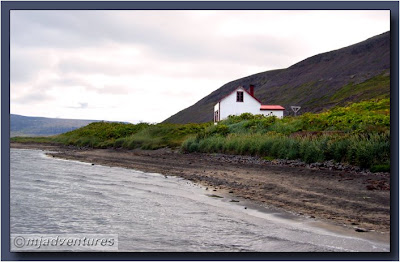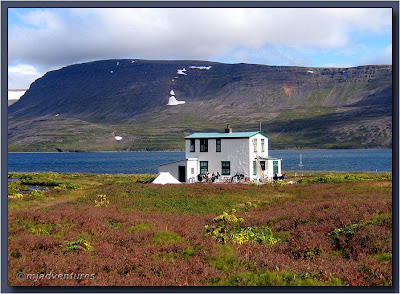Click images to enlarge
 Guarded by high mountains, Hesteyri settlement sits on a gentle slope by the Hesteyrarfjörður (Hesteyri fjörd)
Guarded by high mountains, Hesteyri settlement sits on a gentle slope by the Hesteyrarfjörður (Hesteyri fjörd)So, here we were in Hesteyri, in one of the most isolated parts of Iceland - the West Fjörds. We would never have known about this place if it hadn't been for J's friend who had married an Icelander whose family had always lived in Bolungarvik. Hrólfur is a renown jazz accordionist and we were lucky enough to be treated to his playing on a couple of occasions during our stay. This man can play!
Internet research for Hesteyri proved that it's an isolated place that no one, except for keen hikers, naturalists and Icelanders, knows to visit. Information was sparse and a lot of it only in Icelandic. Little wonder when you see the place - it's so beautiful that I'd want to keep it to myself too!
 Looking down on the settlement of Hesteyri. The headland in the distant left is where Jökulfirðir meets the bigger Ísafjarðardjúp fjörd.
Looking down on the settlement of Hesteyri. The headland in the distant left is where Jökulfirðir meets the bigger Ísafjarðardjúp fjörd.In the 1890s, Norwegians set up a whaling station in Hesteyrarfjörður which is a sub-fjörd of Jökulfirðir. The station was at Stekkeyri which from Hesteyri is an easy >30 minute walk along the fjörd. (More on the whaling station in a future post.)
In 1915, the station closed when Iceland imposed a 10 year ban on whaling in Icelandic waters.
In 1920, Hesteyri was established with private dwellings, a school, shop, church, post office with telephone communication and a resident doctor.
In 1927, a Reykjavik company bought the whaling station from the Norwegians and converted it into a herring factory. In its busiest times, up to 80 people lived in Hesteyri to work in the factory and its support services. It continued to operate until 1940 when the herring stocks began to dwindle due to over-fishing in the area by Iceland and other countries such as Russia and Norway.The factory closure devastated Hesteyri and people were forced to move away to find employment elsewhere.
By 1952, Hesteyri was abandoned, as was the whole Hornstrandir Peninsula.
Today, about 10 houses remain and are maintained and lived in over the Summer by the old inhabitants and their families. No one is allowed to purchase housing or land - the existing dwellings are passed onto family members.
Hesteyri is a popular starting or finishing place for hikes across the mountain ranges, and the ferry service Sjóferðir from Ísafjörður runs regular services to drop off and pick up hikers from various points around the Hornstrandir. Owned by the affable Hafsteins and his wife Kiddý, they are walking encyclopedias when it comes to the history, and their knowledge, of the West Fjörds.
A stone memorial now marks where a wooden church used to sit. The church was a gift from the Norwegian whalers to the village. When Hesteyri was abandoned, the church was transported to Sudavik where it was restored - much to the chagrin of the former Hesteyri inhabitants who feel that the church should have stayed where it was built.
The memorial is recessed to hold the old church bell and a map showing the locations of the graves in the surrounding cemetery and the names of the people buried there.
The cemetery surrounds the old church site.

The settlement gets its water from the many streams which flow down from the snowline. Most of the houses run pipes from the streams for personal use.
The main stream has some beautiful waterfalls on it.
The school house remains and has been restored. It is sometimes used for accommodation on the upper level while the downstairs is still set up as a classroom.
We were staying in the main lodging house in Hesteyri. It's formally known as the Doctor's House, as in Hesteyri's heyday this is where the physician lived and had his clinic set up.
Nowadays, Birna and her family run it as sleeping bag accommodation in bunkrooms. As well, there are coffee cruises from Ísafjörður which come over to Hesteyri, and the passengers are given an historical tour of the area by Kiddý from the ferry company before coming to the Doctor's House for coffee, pancakes and some traditional Icelandic treats made by Birna.
All travellers staying overnight in Hesteyri or going hiking on the Hornstrandir must bring their own food. If staying at the Doctor's House, food can be cooked in the communal kitchen in the house. The mattresses in the bunkrooms are very comfortable and they even have pillows to lend out. The whole place is heated and toasty warm. As well as the inside accommodation, and for a small fee, campers are also welcome to pitch their tents outside the house or in the camping grounds closer to the school house.
Now that we had the general lie of the land, we were ready to explore further afield - and those hills looked inviting!
Next Chapter: The 1st hike












5 comments:
marvelous!
Very beautiful pictures. It makes me realllly want to visit. :)
Thank you Demetrio!
Veiled Muslimah: welcome to our blog! I would love to go back to Iceland one day and this time I want to go back when there's snow on the ground and it's darker. Would love to photograph that time of year although it puts me in the awkward position of being cold when I don't like the cold!
It's all very picturesque!
Sure is!
Post a Comment